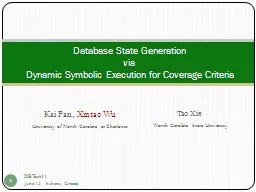PPT-Kai Pan, Xintao Wu University of North Carolina at Charlotte
Author : easyho | Published Date : 2020-10-22
Database State Generation via Dynamic Symbolic Execution for Coverage Criteria Tao Xie North Carolina State University DBTest11 June 13 Athens Greece 1 2 We leverage
Presentation Embed Code
Download Presentation
Download Presentation The PPT/PDF document "Kai Pan, Xintao Wu University of North..." is the property of its rightful owner. Permission is granted to download and print the materials on this website for personal, non-commercial use only, and to display it on your personal computer provided you do not modify the materials and that you retain all copyright notices contained in the materials. By downloading content from our website, you accept the terms of this agreement.
Kai Pan, Xintao Wu University of North Carolina at Charlotte: Transcript
Download Rules Of Document
"Kai Pan, Xintao Wu University of North Carolina at Charlotte"The content belongs to its owner. You may download and print it for personal use, without modification, and keep all copyright notices. By downloading, you agree to these terms.
Related Documents














